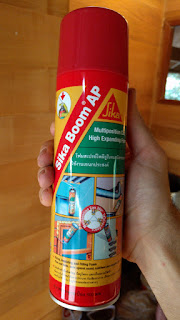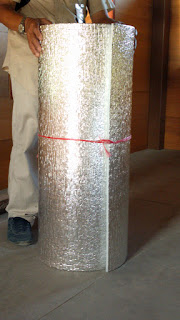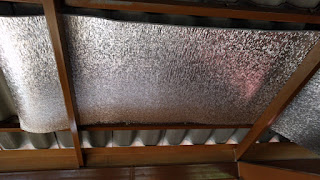About a week ago, we spent some time living in BaanMae and I got to try out the experimental thermal design ideas during the hottest days of summer.
One of the observations is that the sun beating down on the roof generates a lot of heat. The “wind tunnel roof” was doing a pretty impressive job of carrying that heat out of BaanMae. But in BaanLoiNaam, the design is more of a split level with a loft for storage, so the ceiling required to make the “wind tunnel” would be less practical.
So I decided to explore roof insulation options. This is a slightly revised version of the low thermal mass design. Adding insulation does increase the thermal mass of the roof. But so much heat comes in through the roof during the hottest part of the day, it ought to be a pretty darn good trade off. If we can reduce the amount of this heat coming in by >75% during the day, then we are blocking heat from getting in during the hottest part of the day. And any heat that does get in can still vent out through airflow and the side walls at night. A 75% reduction should be conservative since an internet search said the R-value of similar roof tiles is about 0.25 compared to the insulation we are looking into which is rated at about R-20. This should mean about 80x reduction in heat flow compared to bare tiles. But this doesn’t account for imperfections in the insulation such as heat flow between the seams of the sheets, or even worse, the heat conduction through the steel structural beams of the house. Still, even with these losses, it seems likely that the theoretical 80x reduction should be able to achieve at least 4x (75%) reduction in actuality. And some of the insulation options are coated in metal foil and claim to be >90% reflective of radiated heat, meaning reductions in both heat conduction and heat radiation.
If they work out well with out trapping noticeable amounts of heat at night, we might consider adding roof insulation in BaanMae, too.
But for now, we are experimenting with two options on BaanRimNaam…
First, I was interested in a spray-on foam. We contacted a company that does this professionally but they seemed to think that the fiber cement roof tiles were problematic. So I tested it myself using a similar foam insulation that comes in spray can form:
We used this stuff to seal up some of the holes between wall and roof in BaanMae. But it is a bit problematic on roof tiles since there is nothing to support it:
In order to get it to stick, I had to spray it into a bucket and then apply it with a metal plastering spatula. It was slow and tedious work. I suspect it could work for the whole roof, but would likely take about 10-20 man-days to finish.
Praew wasn’t too happy with this level of manual labor required, so we moved on to the next option:
This is a 10mm thick foam sheet with reflective metal foil on both sides to reflect radiated heat. The example roll we bought was 90cm x 4m. I mentioned previously that when we sat on the balcony of BaanMae at noon-time and read books, the breeze seemed to conduct heat away efficiently, but it felt like there was a strong heat radiating onto us from the roof above. (It felt like a heat-lamp pointing our way.) This kind of foil covered sheet might reflect the majority of that radiated heat back up to the roof tiles rather than down to us. (I suspect that we can use a much thinner sheet since it is outdoors so we care much more about reflecting radiation that inhibiting conduction.)
In the roof designs we are using, this kind of sheet is very easy to install just by sliding it between the roof tiles and the steel rafters:
The 90cm width just happens to be the exact distance between the purlins. And there is already a 2-3cm gap in between the rafters and the roof tiles since the tiles rest on the horizontal purlins which are themselves resting on the rafters. So the insulation doesn’t even push the tiles up at all. A horizontal sling wire (parallel to the purlins) would easily hold the insulation in place without sagging noticeably.
I’m also considering purchasing a thinner (2-5mm thick) sheet of similar material to wrap the exposed steel beams to try to reduce the heat flow conducted from the roof through the metal. But this feels more like a second-order concern and can wait until the first-order “insulating 99% of the roof surface area” is done.
A third option we considered is the normal fiberglass insulation sheets. This stuff is cheaper and probably a better insulator. But there seems to be some debate as to whether it is a cancer causing substance. At first it was listed as hazardous, and then it was removed from the list. Now there is concern over whether it was removed prematurely. All of this reminded me too much of the decades long asbestos ordeal (which is also another insulator). So I just figured that it was better to play it safe.
(Polystyrene foam insulation sheets are made from polystyrene, which is in everything from yogurt containers to take-out food packaging to packing foam. Basically, if this stuff turns out to cause lung cancer when humans are exposed to it, we have a lot bigger things to worry about than the roof insulation.)
In my honest opinion, I greatly prefer the spray foam option for aesthetic and sanitary reasons. Aesthetically, it can be scraped flat and then painted with any color paint that we want. From a sanitary standpoint, it sticks to the roof tiles, so it doesn’t leave any gap for animals to nest in or mold or bacteria to grow in. But the foam sheets will be so much easier to install that Praew convinced me to go with this route. I can’t actually think of any nice way of covering it that doesn’t make the sanitary issues even worse (i.e. create even more hiding places or even just make it harder to check for critters nesting up there). So I figure we’ll just install it and see if I can live with it.
Two options for possible consider down the road:
- The spray foam can be sprayed in between the roof tiles and the foam sheet insulation. This is the “both of them” option. The difficult part of the foam was that nothing supported it. Once the sheets are installed, it may be as easy as sticking the spray can in between sheets and roof tiles and spraying. This would add insulation and potentially block nesting space. (But it would need to be done carefully to not leave little “caves” for the critters).
- If the foil on the underside is too ugly, maybe I can glue “builder’s paper” to the underside foil and then just paint the paper.



